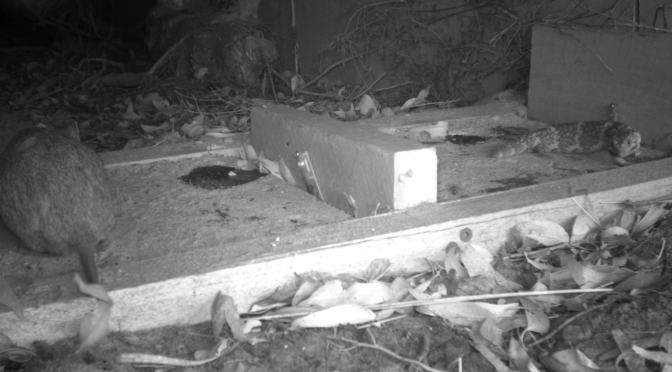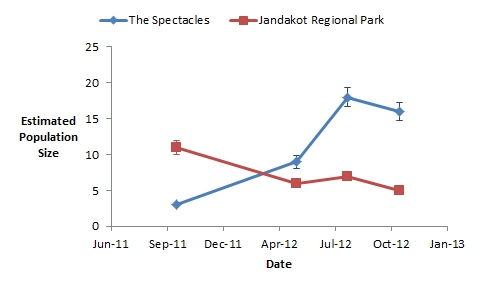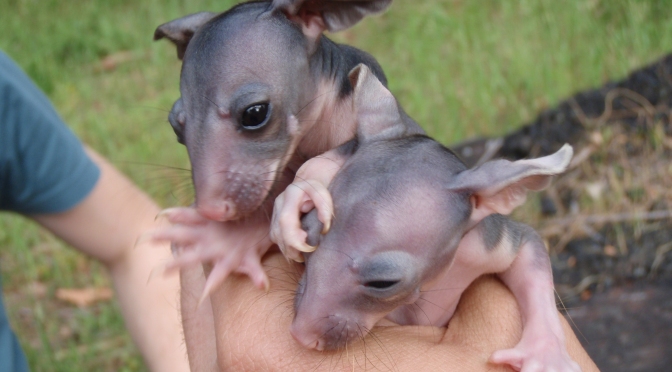My research into the factors affecting the use of underpasses by native fauna has finally been peer reviewed and revised and revised again and is now published. The paper, imaginatively titled, ‘Factors affecting the use of fauna underpasses by bandicoots and bobtail lizards’ was published online in the journal Animal Conservation today and you can get it here. Continue reading Paper: Factors affecting underpass use by bandicoots and bobtails
Tag Archives: bobtail
Crowd funding and conservation: Bobtails and dugites in the suburbs
Getting funding for conservation research is always a struggle, unless you happen to have an oil well or a gold mine in your back yard. Competitive grants are by the very nature rather competitive with Australian Research Council grants having a less than 20% success rate and the majority of them go to people with vast track records and publication lists as long as your arm (or your very long beard). So where do you go to try and find the money for your research when you are just starting out? Continue reading Crowd funding and conservation: Bobtails and dugites in the suburbs
Keeping left, its important when the traffic starts to build
Getting quenda and bobtails to use underpasses: what works and what doesn’t
The project that I’ve been working on for the past couple of years looking at fauna underpasses is coming to an end, which means that it’s time to start producing some results. One of the big questions we were wanting to answer with this work is what factors encourage or discourage native fauna to use underpasses? There were a number of factors that we thought would potentially be important based on what we knew about the ecology and behaviour of the two main study species, the quenda and the western bobtail. These were: underpass length, underpass opening size, vegetation cover near the underpass entrances, furniture inside the underpasses, use by feral predators and the time since the underpasses were constructed. So what was important and what didn’t seem to matter? You’ll have to have a look at our report to find out.
Mandogalup: females still in short supply
I’ve gotten a bit behind with fieldwork updates again, but now that I’ve finished for the year its time to catch up.
A few of weeks ago it was the turn of The Spectacles and Jandakot Regional Park, or the Mandogalup site, to be trapped. It was another week of good numbers of captures with 21 bobtails caught and microchipped, 5 brushtail possums and 42 captures of 21 different quenda. Of the 21 quenda that were caught only 3 were female which unfortunately continues to extreme male bias that I’ve reported on from previous trapping efforts. All three females were also recaptures from previous trapping efforts as well so it appears that no new females are coming into the trapping areas. Just as a comparison of the 21 bobtails captured 8 were male and 13 were female which is much closer to what we would hope to see in terms of relatively even sex ratios. This lack of females, particularly at Jandakot Regional Park, also seems to be playing a role in the drop in numbers that I’ve seen in that area. The graph below shows the estimated population sizes for the quenda populations in the 8ha trapping grids for the two sides of the freeway. The population at the Spectacles has risen quite substantially since I started trapping, but the population at Jandakot Regional Park is following a fairly consistent downward trend. The last time a female quenda was caught at Jandakot Regional Park was September 2011, with nothing but males since.

Walyungup/Cooloongup Lake: Doing my bit for cat control
The past two weeks I have spent trapping at Walyungup and Cooloongup Lakes in Warnbro. This used to be a one week job, but with a huge increase in quenda captures and the large numbers of bobtails over spring I’ve needed to split the area and trap it in two halves.
It was another successful trapping in this area with 48 captures of 23 individual quenda, 63 western bobtails, 2 western bluetongues, 1 tiger snake, 54 rats, 7 mice and 2 feral cats.
The 2 feral cats were both ones that had been using the underpasses for at least the past 6 months, with one of them having taken to sleeping in the underpass as well in August. The photo below shows one of the feral cats curled up asleep on the microchip reader where it stayed on this particular day for 6 hours. At $6000 this would have to make it the most expensive cat bed in the world! Both of the cats that were captured were taken to the Cat Haven in Shenton Park where they are assessed to see if they can be re-homed, or if they are too aggressive then they are humanely destroyed.


Keralup: where the skinks are king
I’m currently in the middle of a week of night-time invertebrate surveys, but last week was a week of trapping at Keralup. For those unfamiliar with the area, Keralup is a Department of Housing property near Karnup, which is planned to become home to 90,000 people by 2050. Having worked out there for a while with the trapping that I’m doing I really can’t understand why anyone would want to live there, unless you really, really like mozzies.
The captures for the week included the usual suspects of 6 quenda, 1 brushtail possum, 32 bobtails, 5 black rats. the numbers of quenda were down a bit on the numbers captured back in the winter, but this may have been partly due to the bobtails taking up the traps.
I also had the not so usual capture of 4 King’s skinks and 1 dugite. Keralup is the only site so far where I’ve captured King’s skinks, which is most likely due to their preference to coastal or riparian habitats.


Paganoni Swamp: If I had a dollar for every bobtail…
…then I’d have 59 dollars. Another week of trapping down, this time at Paganoni Swamp and it was a week chock full of bobtails, plus a few other species as well.
In total I had 66 captures of 59 different bobtails, which given that my trapping grids cover approximately 22ha is really quite impressive. At a density of more than 2 per hectare (although this is an incredibly rough estimate) this would equate to a population of at least 1500 bobtails across the 700ha of Paganoni Swamp Reserve.
One of the challenges of tagging bobtails is being able to accurately sex them, which isn’t always that simple. You can get a general idea from the shape and size of their heads and the length of their tails, but to really be sure it comes down to everting or not verting hemipenes. What’s a hemipenis (singular of hemipenes) I hear you ask, its the name for one of the pair of sex organs in male squamates (the lizards and snakes). See if you can pick which is the male and which is the female in the photo below:

I also caught 2 western bluetongues in the week as well which was the first time I had captured this species in Paganoni Swamp.

I also had a brush-tailed phascogale, a female who has managed to raise 6 young this year judging by the number of lactating teats she had, plus 8 brushtail possums and one quenda. At one of the traps with a brushtail possum in it I had quite a surprise that you can see in the photo below. The adult female was in the trap and when I went to lift up the hessian bag I discovered her quite large young curled up on top of the trap not willing to leave his mum. His mum doesn’t have quite the same sense of loyalty though as I caught the young in a trap the day before with his mother nowhere to be seen.


(BTW: The bobtail on the left is the female and the right is the male)
Mandurah Entrance Rd: Quenda at Black Swan Lake still hanging on.
I’ve just finished (well almost a week ago now) another week of trapping at the Mandurah Entrance Rd site (Marlee Reserve and Black Swan Lake) apart from getting attacked by ticks all week (my total count was 28 that I pulled off me) it was a very successful week. I captured 2 quenda at Black Swan Lake where I thought the population may have gone extinct which was really good. One of these was a female with 5 new born pouch young so hopefully we’ll see that population increase albeit in a rather inbred way.
The twin brushtail possum pouch young that I caught back in June were back and are doing well as you can see below: In total there were 23 captures of 15 individual brushtail possums for the week in Marlee Reserve.

Apart from the 2 quenda caught at Black Swan Lake which was really pleasing I also had 17 captures of 14 different individuals at Lake Marlee. This included a number of females with newborn pouch young and 1 with a couple of very cute furred pouch young, one of which you can see below:

Being spring and with lovely warm weather the reptiles were out in force with 28 individuals bobtails captured for the week, plus 1 black headed monitor (Varanus tristis) and 1 tiger snake.

Roe Highway: where they’re breeding like bandicoots
Roe highway was the site for my last week of trapping and a very successful week it was. The totals for the week came to:
20 Quenda: Plus another 17 large pouch young microchipped. Hopefully we will be able to get some nice data from this site on the survival rates of juvenile quenda once they leave their mothers. This is one of those stages in the life cycles of most native animals that we know very little about so it will be really interesting to see how many of them actually survive once they are weaned.
12 Bobtails
2 Ravens
2Rats
2 House mice

We have also had cameras in the two underpasses at Roe Highway for just over 1 month now and they have been picking up a lot of use by quenda and bobtails, plus the occasional rat and one cat. This is the only site out the five that I’m studying where quenda are using the underpasses so frequently, the challenge is going to be to find out what is so different about this site.

I’m off on holidays now. Spring trapping begins in mid October.










